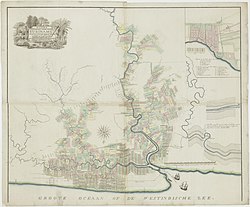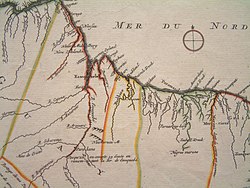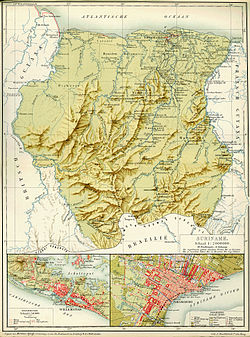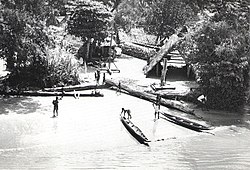
Suriname, officially the Republic of Suriname, is a country in northern South America, sometimes considered part of the Caribbean and the West Indies. Situated slightly north of the equator, over 90% of its territory is covered by rainforests, the highest proportion of forest cover in the world. Suriname is bordered by the Atlantic Ocean to the north, French Guiana to the east, Guyana to the west, and Brazil to the south. It is the smallest country in South America by both population and territory, with around 612,985 inhabitants in an area of approximately 163,820 square kilometers. The capital and largest city is Paramaribo, which is home to roughly half the population.
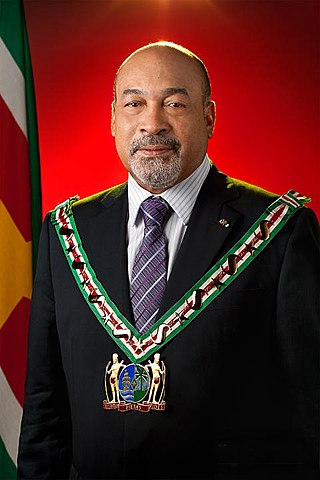
Desiré Delano Bouterse is a Surinamese military officer, politician, convicted murderer and drug trafficker who served as President of Suriname from 2010 to 2020. From 1980 to 1987, he was Suriname's de facto leader after conducting a military coup and establishing a period of military rule. In 1987, Bouterse founded the National Democratic Party (NDP). On 25 May 2010, Bouterse's political alliance, the Megacombinatie, which included the NDP, won the parliamentary elections, and on 19 July 2010, Bouterse was elected as President of Suriname with 36 of 50 parliament votes. He was inaugurated on 12 August 2010.

Fort Zeelandia is a fortress in Paramaribo, Suriname. In 1640 the French built a wooden fort on the spot which, during British colonial period, was reinforced and became Fort Willoughby. It was taken by the Dutch in 1667 and renamed Fort Zeelandia.
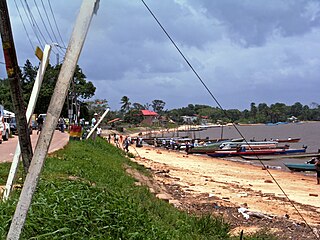
Marowijne is a district of Suriname, located on the north-east coast. Marowijne's capital city is Albina, with other towns including Moengo and Wanhatti. The district borders the Atlantic Ocean to the north, French Guiana to the east, the Surinamese district of Sipaliwini to the south, and the Surinamese districts of Commewijne and Para to the west.
The Jungle Commando was a guerrilla commando group in Suriname. It was founded by Ronnie Brunswijk in 1986 to ensure equal rights for Suriname's minority Maroon population. The group was formed after the Suriname troops committed mass murder against 35 people in Moiwana Village, near Moengo, after the Suriname national army failed to capture Ronnie Brunswijk. The Commando fought against Dési Bouterse and the Surinamese army in the Suriname Guerrilla War.
The December murders were the murders on 7, 8, and 9 December 1982, of fifteen prominent young Surinamese men who had criticized the military dictatorship then ruling Suriname. Thirteen of these men were arrested on December 7 between 2 am and 5 am while sleeping in their homes. The other two were Surendre Rambocus and Jiwansingh Sheombar who were already imprisoned for attempting a countercoup in March 1982. Soldiers of Dési Bouterse took them to Fort Zeelandia, where they were heard as "suspects in a trial" by Bouterse and other sergeants in a self-appointed court. After these "hearings" they were tortured and shot dead. The circumstances remain unclear. On 10 December 1982, Bouterse claimed on national television that all of the detainees had been shot dead "in an attempt to flee".

General elections were held in Suriname on 25 May 2005. The governing New Front for Democracy and Development of president Ronald Venetiaan lost seats, remaining the largest party but failing to get a majority in the National Assembly of Suriname. Despite this Venetiaan was re-elected as president after obtaining sufficient support to win a majority in the election for president.

General elections were held in Suriname on 25 May 2010.

The Surinamese Interior War was a civil war waged in the Sipaliwini District of Suriname between 1986 and 1992. It was fought by the Tucayana Amazonas led by Thomas Sabajo and the Jungle Commando led by Ronnie Brunswijk, whose members originated from the Maroon ethnic group, against the National Army led by then-army chief and de facto head of state Dési Bouterse.

The Ndyuka people or Aukan people (Okanisi), are one of six Maroon peoples in the Republic of Suriname and one of the Maroon peoples in French Guiana. The Aukan or Ndyuka speak the Ndyuka language. They are subdivided into the Opu, who live upstream of the Tapanahony River in the Tapanahony resort of southeastern Suriname, and the Bilo, who live downstream of that river in Marowijne District.

The 1980 Surinamese coup d'état, usually referred to as the Sergeants' Coup, was a military coup in Suriname which occurred on 25 February 1980, when a group of 16 sergeants of the Surinamese Armed Forces (SKM) led by Dési Bouterse overthrew the government of Prime Minister Henck Arron with a violent coup d'état. This marked the beginning of the military dictatorship that dominated the country from 1980 until 1991. The dictatorship featured the presence of an evening curfew, the lack of freedom of press, a ban on political parties, a restriction on the freedom of assembly, a high level of government corruption and the summary executions of political opponents.

Ronnie Brunswijk is a Surinamese politician, businessman, former rebel leader, footballer and convicted drug trafficker, who is serving as the current Vice President of Suriname.

Afro-Surinamese are the inhabitants of Suriname of mostly West African and Central African ancestry. They are descended from enslaved Africans brought to work on sugar plantations. Many of them escaped the plantations and formed independent settlements together, becoming known as Maroons and Bushinengue. They maintained vestiges of African culture and language. They are usually split into two ethnic subgroups.

Surinam, also unofficially known as Dutch Guiana, was a Dutch plantation colony in the Guianas, bordered by the equally Dutch colony of Berbice to the west, and the French colony of Cayenne to the east. It later bordered British Guiana from 1831 to 1966.

Chandrikapersad "Chan" Santokhi is a Surinamese politician and former police officer who is the 9th president of Suriname, since 2020. After winning the 2020 elections, Santokhi was the sole nominee for president of Suriname. On 13 July, Santokhi was elected president by acclamation in an uncontested election. He was inaugurated on 16 July.

Mohamed Rashied Doekhi is a Surinamese politician and a former district commissioner of Nickerie. Because of his popularity in the western rice district, he is nicknamed the president of Nickerie. He was a member of the National Assembly of Suriname, between 2000 and 2020 on behalf of the National Democratic Party of Dési Bouterse.

Netherlands–Suriname relations refers to the current and historical relations between the Netherlands and Suriname. Both nations share historic ties and a common language (Dutch) and are members of the Dutch Language Union.

The nations of Mexico and Suriname established diplomatic relations in 1975. Both nations are members of the Association of Caribbean States, Community of Latin American and Caribbean States, Organization of American States and the United Nations.

The 1990 Surinamese coup d'état, usually referred to as the Telephone Coup, was a military coup in Suriname on 24 December 1990. The coup was carried out by the acting commander-in-chief of the Suriname National Army (SNL), Police Chief Ivan Graanoogst. As a result of the coup, President Ramsewak Shankar was dismissed from power, and parliament and government were disbanded.

The Moiwana Massacre was a massacre perpetrated by the armed forces of Suriname on the Maroon village of Moiwana on 29 November 1986.


